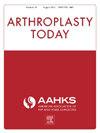Biomechanical Analysis of the Rebar Technique for Tibial Defects in Total Knee Arthroplasty
IF 2.1
Q3 ORTHOPEDICS
引用次数: 0
Abstract
Background
Tibial defects in total knee arthroplasty require appropriate fixation for stability. Smaller defects are treated with cement or a screw and cement construct (rebar technique), while larger defects may require augments. Prior studies validate screws and cement for small defects but caution against use beyond 5 mm. This study compares the stiffness and subsidence of cement-only vs rebar techniques in larger contained and uncontained defects.
Methods
Thirty-two proximal tibial composite bone analogs were divided into 2 groups: (1) Cemented and (2) Rebar, with subgroups for contained and uncontained defects (8 each). Tibial defects mimicked Anderson Orthopaedic Research Institute Bone Defect Classification T1 and T2A classifications. Tibial baseplates were implanted using either cement alone or with a rebar technique (2 6.5 mm cancellous screws). Samples were mounted to a testing fixture simulating heel strike and underwent 10,000 cycles at 1 Hz. Tracking points were placed on each sample to measure displacement. Load and displacement data from the test frame were also collected.
Results
In the contained defect subgroup, rebar showed higher stiffness than cement alone, but the difference was not statistically significant (P = .349) and both groups had similar micromotion (P = .989). In uncontained defects, cement-only showed slightly higher stiffness than rebar (P = .655), with no statistical difference in micromotion (P = .893). Uncontained defects exhibited significantly more micromotion than contained defects (P = .0018, P = .0055).
Conclusions
Rebar and cement-only techniques demonstrated similar biomechanical performance in tibial defects up to 1 cm. The cement and screw technique remains a viable option but may not be necessary in primary and revision total knee arthroplasty.
全膝关节置换术中钢筋技术治疗胫骨缺损的生物力学分析
背景:全膝关节置换术中胫骨缺损需要适当的固定以保持稳定性。较小的缺陷用水泥或螺钉和水泥结构(钢筋技术)处理,而较大的缺陷可能需要增加。先前的研究证实螺钉和水泥可以治疗小的缺陷,但注意不要使用超过5毫米的缺陷。本研究比较了水泥与钢筋技术在较大的含和不含缺陷中的刚度和沉降。方法32例胫骨近端复合骨类似物分为2组(1)骨水泥(cement)和(2)钢筋(Rebar),含骨缺损亚组和不含骨缺损亚组各8例。胫骨缺损模拟安德森骨科研究所骨缺损分类T1和T2A。胫骨基板采用单独水泥或钢筋技术(2枚6.5毫米松质螺钉)植入。样品被安装到模拟脚跟撞击的测试夹具上,并以1hz的频率进行10,000次循环。在每个样品上放置跟踪点以测量位移。还收集了试验车架的载荷和位移数据。结果含缺陷亚组中钢筋的刚度高于水泥,但差异无统计学意义(P = .349),两组微动相似(P = .989)。在未包含的缺陷中,仅水泥的刚度略高于螺纹钢(P = .655),微运动无统计学差异(P = .893)。未包含缺陷比包含缺陷表现出更多的微动(P = 0.0018, P = 0.0055)。结论钢筋和骨水泥技术在1 cm以内的胫骨缺损中表现出相似的生物力学性能。骨水泥螺钉技术仍然是一种可行的选择,但在初次和翻修全膝关节置换术中可能不是必需的。
本文章由计算机程序翻译,如有差异,请以英文原文为准。
求助全文
约1分钟内获得全文
求助全文
来源期刊

Arthroplasty Today
Medicine-Surgery
CiteScore
2.90
自引率
0.00%
发文量
258
审稿时长
40 weeks
期刊介绍:
Arthroplasty Today is a companion journal to the Journal of Arthroplasty. The journal Arthroplasty Today brings together the clinical and scientific foundations for joint replacement of the hip and knee in an open-access, online format. Arthroplasty Today solicits manuscripts of the highest quality from all areas of scientific endeavor that relate to joint replacement or the treatment of its complications, including those dealing with patient outcomes, economic and policy issues, prosthetic design, biomechanics, biomaterials, and biologic response to arthroplasty. The journal focuses on case reports. It is the purpose of Arthroplasty Today to present material to practicing orthopaedic surgeons that will keep them abreast of developments in the field, prove useful in the care of patients, and aid in understanding the scientific foundation of this subspecialty area of joint replacement. The international members of the Editorial Board provide a worldwide perspective for the journal''s area of interest. Their participation ensures that each issue of Arthroplasty Today provides the reader with timely, peer-reviewed articles of the highest quality.
 求助内容:
求助内容: 应助结果提醒方式:
应助结果提醒方式:


